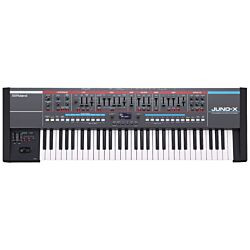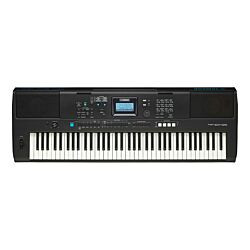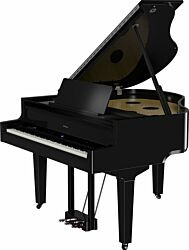1. Introduction
Before you buy a digital piano you need to assess what your demands regarding the instrument are. No matter your skill level, there will always be some criteria and considerations when you are choosing an instrument. One of these criteria could be: What's the max price? Today you can find a lot of cheap digital pianos, but usually the quality is reflected in the price. Therefore, consider what you can afford so that you do not compromise your other demands.
Maybe it has to have a specific size, colour, look or functions, or has to be portable - you have to ask yourself, "would I be happy and inspired by looking at and playing that instrument in my living room every day?". I bet you didn't know you had so many demands!
The digital piano was invented in the 70's, but it was not until the 80's that its price was made accessible for the common family - So they could buy pianos for their living room, office and for the children's room. The digital piano is a very popular choice nowadays because of their light weight and compact construction, and the option of adjusting volume or connecting headphones.
(Digitalpiano.com and) Juhl-Sørensen have been retailers of acoustic pianos and grand pianos since 1895, and of digital pianos since the beginning of the 80's. We have been following the recent development that more people have been choosing digital pianos instead of acoustic pianos, partly because of the price and partly because of the digital functions. Many teachers acutally recommend the digital piano as a learning instrument for beginners.
Our goal is to spread the joy of playing the piano to as many as possible, no matter if it's digital or acoustic.
Enjoy!
2. History
A digital piano is a electric instrumet which recreates a sampled sound through the speakers and simulates the sound and feel of an acoustic piano. The first digital pianos were produced in the 70's in Italy and Japan, but the keys weren't touch sensitive. During the 80's, that feature was incorporated and the instruments fell in price so that the "common family" could afford hem. Up through the 90's another feature was invented - weighted keys, and these years also saw an improvement in the piano sampling.
Today the digital piano is a great alternativ to the acoustic piano; with weighted and touch sensitive keys you have the opportunity to play the piano "traditionally", but you also have a lot of different sounds and the ability to record what you play. These features are common in all digital pianos today. You can still find keyboards with non-weighted keys, but many keyboards feature weighted keys.
To simulate an acoustic piano is not easy because of the very complex hammer and key action.
Today, most of the companies spend a lot of time recording and fine tuning their samples. If you play on a Kawai or Yamaha digital piano, the sound is sampled from their acoustic grand pianos. Read more about that here: 4. Sounds
The characteristic that makes the digital piano stand out most from the acoustic is the fact that you can adjust the volume of the instrument without compromising the dynamics, and that you can play with headphones if you want to play in private or without disturbing others.
3. Brands
On the european market, there are around 10 different digital piano brands and even more stage piano and synthesizer brands. The best course of action is to try to play, listen to the sound, and take a close look at the instrument in which you are interested. If that's not possible, then you can find reviews - either written reviews or video reviews, that can help you make the best decision.
If you start with price as the decisive factor, take a closer look at the instruments within your price range, and see what the different models offer. Almost all the brands on the european market make good instruments, but there are a few that stand out: Kawai, Yamaha, and Roland. Why? They are all Japanese brands with a lot of experience. Kawai and Yamaha have produced acoustic instruments since the beginning of the 1900s. You can be sure that all of their expertise in key action and sound has been applied in the making of their digital instruments. Roland, on the other hand, doesn't produce any acoustic instruments, but they have been in the digital instrument game since the start, and have built a good reputation for their brand.
Korg and Casio, which are also japanese companies, have also been making electronic digital instruments since the start. The new brand Dexibell, is an italian company that produced instruments for Roland for many years. Now they have started their own production and are one of the few european built instruments.
Let's go back to the question - which brand should I go for? There is no easy answer to that, because there are a lot of differences between the brands, such as sound, looks, and key action, and which piano you will like the most is very subjective. If you're really looking for the "real" piano experience, take a look at Kawai or Yamaha. However, you may find that you prefer another brand once you've tried out some of our instruments, and that's alright! The best thing to do is to drop by one of our showrooms and try the pianos out for yourself.
We are looking forward to seeing you!
4. Sounds
One of the most important factors when choosing a digital piano is whether or not you like the sound you hear. Everyone has an idea of how a piano should sound, and there is no clear right or wrong answer. If we look at it historically, the common opinion is that Steinway & Sons' sound is the pinnacle of piano sound that everyone wants to recreate. But that doesn't necessarily mean that it's the right sound for you or your budget. Therefore, we advice you to try some different brands and models.
There are two things to keep an eye out for:
First of all, evaluate the performance of the instrument's in-built speaker system. Maybe the pure sound isn't bad, but it's compromised by the small speaker size. If you buy a more expensive digital piano, then the speakers get bigger and better at reproducing the piano sample. If you play with some good headphones, then you will get a more precise recreation of the sound, which resembles the original acoustic sampling more closely. Therefore, don't judge the instrument solely based on its tone, but also based on it's speakers.
Secondly, the brands have different ways of sampling. For instance when you play on a Kawai digital piano, it's samples are from Kawai acoustic grand pianos, and the same goes for Yamaha. On the Korg, Casio, Roland and Dexivell pianos, it's a different story because they don't have any acoustic instruments to sample. The samples you hear in these instruments are a combination of computer generated sound and samples from different acoustic brands like Yamaha, Kawai, Steinway & Sons, Bösendorfer and so on.
To recap, You don't have to worry too much about the sound quality, because even in the cheaper models, you get a good sound, especially with headphones on. Of course the speakers and variety of samples get better as the models get bigger, but the price also increases.
There is only one person that knows how your piano should sound and that is you!
5. Keys
There are a lot of differences when looking at keys - on both digital and acoustic instruments. Once again, prefered touch sensitivity and mechanism are very subjective, but if you ask the experts, the "best key action" is what you find on the grand piano, and this is what the digital pianos try to replicate. It is diffcult to develop a key action because you need to be able to play every nuance possible - delicately, powerfully, expressively, frenetically, gracefully and mournfully. The key action of an acoustic upright and an acoustic grand is very different, but there are also a lot of differences in the feel of the key action between different brands of upright pianos. It is similar in the digital piano world as well; often actions are built similarly, but they also differ from one another in several ways.
Today, the brands have come long way in building digital pianos with realistic-feeling key actions. If you go a bit up in price, you will find wooden keys, and in some instruments, even a real upright or grand piano action. The wooden keys are considered to recreate the most realistic feeling when you play, but the plastic key actions are also worthy of consideration.
You need to like the feeling when you are playing, and it may be that you prefer plastic keys to wooden keys. It's important to try a lot of different models. Why? Because the feeling is important for your future playing. If the keys don't feel good in a couple of years, you may lose the motivation to play or you'll have to buy a new one.
We normally advice that digital pianos from 3.000 - 10.000 DKK can be played on 2-5 years and help you become a better player. A digital piano above 10.000 DKK can be used for more than 5 years, and for some people, even for the rest of their life. For a serious developing player, the next step would be switching to acoustic instruments.
So whether you're an absolute beginnner, or an experienced professional, we'd love to help you find a piano that meets your demands and inspires your musical pursuits. Feel free to visit us any time!
6. Functions
The functions below are the most common functions included with digital pianos today. They are important because some of them might help you develop more quickly.
Metronome
A metronome helps you to play steadily. You set a tempo which can be heard as a clicking sound from the instrument. The tempo is measured in beats per minute. The metronome can also be set to match different time signatures or to play only certain beats. A metronome is a great tool for improving your technique, learning to play a song more quickly, practicing sight reading, and developing a sense of rhythm.
Recorder
A build-in recorder is useful in many practice situations. Besides it being fun to hear yourself play, it is useful for self-critique when you are trying to perfect your technique or develop your musical expressiveness for any piece of music. Several instruments offer multi-track recording, and if that's not enough, most digital pianos can be connected to a computer. With the help of a digital audio workstation and complementary software, you can record as many tracks as you like with your computer.
Transpose
With the transpose function, it's possible to change keys with a press of button. When you change keys, the starting note changes and all the following chords change aswell. This can be useful if you are playing in an ensemble or accompanying vocals. Let's say that you've learned an accompaniment or score in the key of C, but suddenly need to play it in the key of F. With the transpose function, you can play the original music, without printing and learning it in a new key, and the piano will transpose what you play into the key of F automatically.
Polyphony
Polyphony is not a funtion but more like a concept, which is well known in the world of digital pianos. Imagine you are looking for a new computer, typically the one the most RAM is the best computer. It's kind of the same when it comes to polyphony. For most people, a polyphony of 128 is fine but 256 is also available. Polyphony is an expression of how many notes can be played and held at once. If you imagine that you'll need to press all the keys at once (which isn't everyday), it's great to have as much polyphony as possible. If you play very advanced piano pieces, it will also be ideal to have a digital piano with high polyphony.
Bluetooth
Bluetooth is a function found in many digital pianos today. But what do you use it for? In most cases it is both Bluetooth MIDI and Bluetooth Audio. Bluetooth MIDI sends the same information as if you had a cable connected to your computer or iPad or other smart device. This is very handy and now you can easily record directly to Garageband or write notes directly into a sheet music program by simply playing on the instrument, without connecting cables. Some digital pianos also use the Bluetooth functionality to connect to the brand's app, which is developed to help you control and adjust the settings in you digital piano. For example, if you have a Roland digital piano, you could use their Piano Partner 2 app. Bluetooth audio can be used to play all kinds of music through the speakers of your piano, whether you want to play along, or have it playing in the background while you do something else.
7. Speakers
As you perhaps read under 4., it's not only the speakers that determine the sound quality of your digital piano. The speakers determine how loud it can play and the number and type of speakers determine where the sound comes from, and which registers are projected most prominently. The different brands have their own unique ways of placing the speakers. Some choose to place them under the instrument, while others place them in front of you, which makes the sound more direct. What you prefer will be very subjective. The most important thing is that the playing experience feels as realistic as possible.
How many watts (W) do you need? We recommend 12-20 W if the instrument is meant to be placed in a living room og a medium sized room, and that is also plenty if you live in an apartment. If you have a bigger room, we recommend over 20 W. Some instruments have less than 12 W speakers, and that might be plenty if you're mainly playing for yourself. The sound of the speakers is very difficult to compare - no rooms are exactly the same, so the piano can sound completely different in our showrooms than in your home.
The main point is this: Don't judge the instrument only by the sound of the speakers.
Judge it especially by the the quality of the sound, the looks of the instrument, and the presence of other functions you're looking for - and, of course, it has to be in your price range!
Back to the top
























































